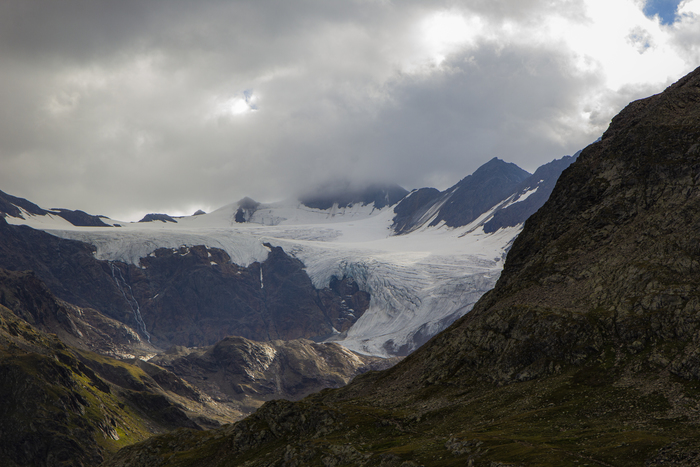(ANSA) - BORMIO, AUG 26 - A loss of thickness of about one meter a year and a huge retreat of 500 meters between 1925 and 2020 (5 meters a year) characterize the Sforzellina glacier, while the Forni, in the municipal area of Valfurva (Sondrio), the second largest in Italy by area, reports a frontal regression of 2 km in the last 150 years, going from 13.2 km of surface in 1981 to 11 km today.
In a nutshell, this is the result of the monitoring carried out in the third leg of the Caravan of the glaciers of Legambiente on the two glaciers Sforzellina and dei Forni, both in Valtellina.
The results of the monitoring were presented in Bormio (Sondrio): "Even the vast Forni glacier is inexorably shrinking - declares Vanda Bonardo, responsible for Alpi Legambiente -. Together with the Sforzellina, these glaciers remind us of what we have already observed in the western sector of the Alps. : a trend towards the reduction of the glacial mass in line with the situation in the southern sector of the Alps. It is urgent to implement ambitious climate measures and policies to achieve net emissions equal to zero by 2040, in line with the Paris Agreement " .
The Sforzellina glacier, the first of the two to be observed on August 23 by the Caravan of glaciers - explains Legambiente - is among the most important as regards the completeness of the data collection, since it is among the few Italian glaciers that boast a series thirty years of mass balance measurements, i.e. the difference between the accumulation and melting losses of snow and ice. The studies carried out show that the loss of thickness is about one meter per year, with an evident acceleration in the last decade. Furthermore, it is easy to quantify the deglaciation that took place after the Little Ice Age, (a cold period that began in the fourteenth century and ended in the mid-nineteenth century), whose moraines are generally not so evident; in the case of the Sforzellina they are easily identifiable and concretely show us how much the glacier has retreated in this last century and a half. The succession of measurements shows a huge shrinkage that amounts to about 500 meters between 1925 and 2020, halving the length it had in the 1920s. The Sforzellina is also transforming itself from a "white" glacier, devoid of debris cover (debris free glacier ), a “black” glacier (debris covered glacier).
The Forni glacier, with its 11 km2 is one of the largest Italian glaciers, second in surface area only to Adamello-Mandrone. The ascent and monitoring were carried out by the Legambiente Glacier Caravan on Monday 24 August. Classifiable as a “valley glacier with compound or confluent basins”, it is made up (or rather it was made up) of three collector basins from which as many flows descend with vast seracs which flow into a central area, forming a single tongue. In reality, in the last decade the flows coming from the upper basins have become increasingly thinned and fragmented, so much so that currently only the central basin is able to fully feed the tongue. In recent years the glacier has rapidly begun to fragment into three distinct individuals, two of which (Eastern and Western) are turning into circus glaciers. The separation of the eastern basin from the central tongue took place in the summer of 2015. Thanks also to the installation in 2005 on the tongue at 2700 meters of the first Italian automatic meteorological station on the glacier, still functioning today, they are currently being carried out by the University of Milano researches the glacier melting rate based on available solar and atmospheric energy. The station data also allows us to quantify the glacier's ability to reflect solar radiation. This property called albedo is decreasing more and more due to the blackening of the glaciers. The quantity of melt water is also quantified thanks to the Idrostelvio network, a hydrological monitoring network developed by the Stelvio Park with the collaboration of the University and Polytechnic of Milan which measures the flow of streams fed by the melting of snow and glacier It is clear that the glacier and the park are a real open-air laboratory.
The total surface area of the glacier went from 13.2 km2 in 1981, to 12.9 km2 in 1991, to 12 km2 in 2003, to 11.3 km2 in 2007, to 11.1 km2 today. This glacier is also getting darker in recent years. However, this is not solely due to the increase in debris cover. Another phenomenon that interests him is that of black carbon, consisting of dust deriving from atmospheric pollution of anthropogenic origin from fires and pollutants arriving from the plain. This component, contrary to what occurs due to a debris cover of a certain thickness, causes the glacier to melt more rapidly.
Legambiente, the retreat of glaciers continues in Lombardy
2020-08-26T17:58:41.844Z

(HANDLE)(ANSA) - BORMIO, AUG 26 - A loss of thickness of about one meter a year and a huge retreat of 500 meters between 1925 and 2020 (5 meters a year) characterize the Sforzellina glacier, while the Forni, in the municipal area of Valfurva (Sondrio), the second largest in Italy by area, reports a frontal regression of 2 km in the last 150 years, going from 13.2 km of surface in 1981 to 11 km today. ...
